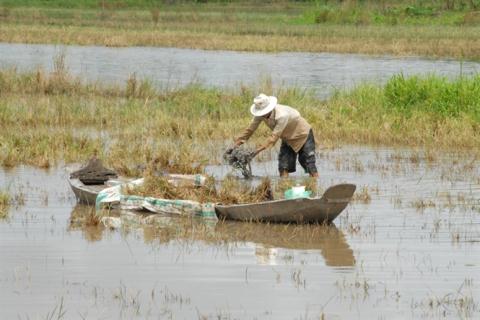Overexploited rivers dying
Rivers have been overexploited, causing tremendous pressure on the livelihoods and water sources of the communities living on the riverbanks.
Vietnam, rivers, Red River, Hanoi, vietnamnet bridge, english news, Vietnam news, news Vietnam, vietnamnet news, Vietnam net news, Vietnam latest news, Vietnam breaking news,
Rivers have been overexploited
Tran Thi Le Anh of the Waste Management and Environment Improvement Agency said that scientists’ warning that rivers would suffer from uncontrolled economic development activities has come true.
Anh pointed out that the river quality has declined seriously, especially the sections which run across urban areas, industrial zones and craft villages. The situation is especially serious in the three basins of Cau, Nhue-Day and Dong Nai rivers.
Rivers have been overexploited, causing tremendous pressure on the livelihoods and water sources of the communities living on the riverbanks.
The Cau River now receives 80,390 cubic meters of waste water every day from the production workshops outside industrial zones and 86,560 cubic meters from craft villages.
The volume of waste water from farm and food produce processing villages is the highest – 57,484 cubic meters a day, which accounts for 66.4 percent of total waste water capacity.
Meanwhile, paper production villages produce 18,057 cubic meters of waste water. Scientists have warned that the water indexes in 2015 showed the quality of the water on Cau River is getting worse.
In the south, the upper course area of the Sai Gon River which borders Binh Phuoc, Binh Duong and Tay Ninh provinces, has been ‘choked to death’ for several years by waste water from the farm produce processing factories.
The river sections which run across the three provinces have changed its color, covered with the green mud layer on the surface. The polluted river has deprived the livelihood of hundreds of fishermen along the Sai Gon River.
Meanwhile, according to the management board of the project on Dong Nai & Nhue-Day Rivers’ pollution control, the four existing provinces near the rivers’ basins and seven new provinces will need VND600 billion, or $27 million, to treat the pollution there.
Anh believes the major problem lies in the unreasonable water source management scheme.
In principle, the Ministry of Natural Resources and the Environment (MONRE) is the agency taking the major responsibility for the water natural resources and river valley environmental protection.
However, some other ministries also have the power of granting licenses to exploit rivers. Each of them promulgates legal documents and sets its own rules.
Nguyen Hong Toan, former secretary of the Vietnam Mekong River Committee, agrees that the biggest challenge now for river management is the institutional challenge.
The government decree No 120 dated in 2008 on river valley management stipulates that river valley committees would be set up to be in charge of settling inter-provincial issues. However, to date, no such a committee has been established.
Vietnam, rivers, Red River, Hanoi, vietnamnet bridge, english news, Vietnam news, news Vietnam, vietnamnet news, Vietnam net news, Vietnam latest news, Vietnam breaking news,
Rivers have been overexploited
Tran Thi Le Anh of the Waste Management and Environment Improvement Agency said that scientists’ warning that rivers would suffer from uncontrolled economic development activities has come true.

Rivers have been overexploited
Anh pointed out that the river quality has declined seriously, especially the sections which run across urban areas, industrial zones and craft villages. The situation is especially serious in the three basins of Cau, Nhue-Day and Dong Nai rivers.
Rivers have been overexploited, causing tremendous pressure on the livelihoods and water sources of the communities living on the riverbanks.
The Cau River now receives 80,390 cubic meters of waste water every day from the production workshops outside industrial zones and 86,560 cubic meters from craft villages.
The volume of waste water from farm and food produce processing villages is the highest – 57,484 cubic meters a day, which accounts for 66.4 percent of total waste water capacity.
Meanwhile, paper production villages produce 18,057 cubic meters of waste water. Scientists have warned that the water indexes in 2015 showed the quality of the water on Cau River is getting worse.
In the south, the upper course area of the Sai Gon River which borders Binh Phuoc, Binh Duong and Tay Ninh provinces, has been ‘choked to death’ for several years by waste water from the farm produce processing factories.
The river sections which run across the three provinces have changed its color, covered with the green mud layer on the surface. The polluted river has deprived the livelihood of hundreds of fishermen along the Sai Gon River.
Meanwhile, according to the management board of the project on Dong Nai & Nhue-Day Rivers’ pollution control, the four existing provinces near the rivers’ basins and seven new provinces will need VND600 billion, or $27 million, to treat the pollution there.
Anh believes the major problem lies in the unreasonable water source management scheme.
In principle, the Ministry of Natural Resources and the Environment (MONRE) is the agency taking the major responsibility for the water natural resources and river valley environmental protection.
However, some other ministries also have the power of granting licenses to exploit rivers. Each of them promulgates legal documents and sets its own rules.
Nguyen Hong Toan, former secretary of the Vietnam Mekong River Committee, agrees that the biggest challenge now for river management is the institutional challenge.
The government decree No 120 dated in 2008 on river valley management stipulates that river valley committees would be set up to be in charge of settling inter-provincial issues. However, to date, no such a committee has been established.

Leave your comment on this story